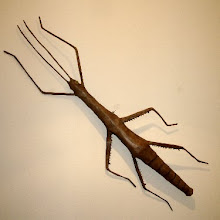As mentioned before, there are two membranes between the albumen (white) and the shell. Now I know their names: the inner (egg) membrane, membrane putaminis (putamen is Latin for pod or husk), and the outer (shell) membrane, the membrane testae (testa is Latin for shell).
The outer surface of the inner membrane is firmly cemented to the inside of the outer membrane, except in a small area, usually at the blunt end of the egg.As for the shell itself:
The fibers of the outer surface of the shell membrane are so firmly embedded in the inner surface of the shell that it is difficult to detach the membrane without tearing it.
It is composed of two widely different materials: an organic matrix, or framework, of delicate, interwoven fibers, and an interstitial substance composed of a mixture of inorganic salts. The proportions of these constituents vary in the eggshells of different species of birds. In the shell of the hen’s egg, there is roughly one part of matrix to fifty parts of mineral matter. The organic matrix is a collagen-like protein; the minerals, mainly carbonates and phosphates of calcium and magnesium. Of the latter substance, calcium carbonate is by far the most plentiful. In mineral composition, the eggshell is strikingly similar to limestone.
The numbers indicate: 1, cuticle; 2, spongy layer; 3, mammillary layer; 4, shell membrane; 5, mammilla (mammillary knob); 6, protein matrix material forming the core of the mammilla; 7, protein matrix of shell; 8, pore in the decalcified eggshell; 9, space in a mammilla remaining after the organic core has been removed by burning.
And as for the colors:
Now you know. How the colors are distributed (evenly across the surface, in spots or splotches) depends on where in the shell formation process the egg is when the pigments are deposited.The colors of birds' eggshells are due to two major pigments, red-brown and blue-green, which were first identified with the bile pigments — the brown with bilirubin, and the green with biliverdin (Wicke, 1858). The shell pigments are now considered to be more closely related to the hemoglobin of the blood than are the bile pigments.
The red-brown pigment of the eggshell has been named oöporphyrin (Fischer and Kögl, 1923, 1924; Fischer and Müller, 1925; Bierry and Gouzon, 1939). This pigment may easily be converted into hematoporphyrin, which shows a red luminescence in ultraviolet light, of wave length of 3660 angstrom units, generated by a quartz-mercury lamp (Hulsebosch, 1927). Hematoporphyrin is probably related t hematin, which is a decomposition product of the hemoglobin of the blood.
The brown eggshells of the domestic fowl are rich in oöporphyrin. According to Voelker (1940), oöporphyrin is present in the shell of whit eggs (at least those of the chicken, duck, goose, pigeon, and owl) when they are laid, but it is quickly destroyed by light. Oöporphyrin was also found in the eggshells of many other species, including a number of passerine birds.
The blue-green pigment of some highly colored eggshells was named oöcyan by Sorby (1875). The chemical properties of this pigment indicate that it is a substance containing three pyrrole rings (Lemberg, 1931). According to Tixier (1945), the green pigment of the emu egg is the methyl ester of biliverdin IXa.
Being a thorough book, there is also a section on artistic uses of eggs and eggshells. The author includes the following paragraph and illustration:
Eggshell Mosaics.
The production of mosaics, by inlaying small pieces of glass, tile, enamel, or a variety of other substances, is an ancient craft that has frequently reached a high degree of artistry. It is also practiced as a hobby. Among the materials that have been used for this purpose is colored eggshell, which has been found adaptable for making many novel designs (Fig. 422). The shells are broken into pieces from 1/8 to ¼ inch in diameter, dyed, and glued to a base in the desired arrangement.




No comments:
Post a Comment